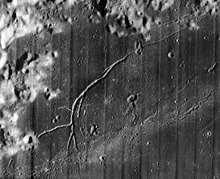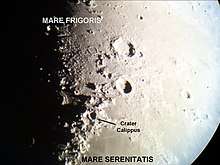Calippus (crater)
Calippus is a small lunar impact crater that is located on the eastern edge of the rugged Montes Caucasus mountain range in the northern part of the Moon. It was named after Greek astronomer Callippus of Cyzicus.[1] It lies to the southwest of the crater remnant Alexander, to the northwest of the Mare Serenitatis.
 Mosaic of Lunar Orbiter 4 images | |
| Coordinates | 38.9°N 10.7°E |
|---|---|
| Diameter | 32 km |
| Depth | 2.7 km |
| Colongitude | 350° at sunrise |
| Eponym | Callippus |
The outer rim of Calippus has an irregular appearance, with outward bulges to the northeast and particularly to the west where there is an interior shelf of slumped material. The exterior has a slight rampart that is surrounded by the rugged terrain of the mountain range. Within the sharp-sided interior walls is a rough and irregular interior floor.
To the southeast of this crater, on the edge of the Mare Serenitatis, is an arcing rille designated Rima Calippus. This cleft follows a path to the northeast for a length of about 40 kilometers.
Satellite craters

By convention these features are identified on lunar maps by placing the letter on the side of the crater midpoint that is closest to Calippus.


| Calippus | Latitude | Longitude | Diameter |
|---|---|---|---|
| A | 37.0° N | 7.9° E | 16 km |
| B | 36.0° N | 10.0° E | 7 km |
| C | 39.6° N | 9.1° E | 40 km |
| D | 36.3° N | 11.3° E | 4 km |
| E | 38.9° N | 11.9° E | 5 km |
| F | 40.5° N | 10.0° E | 6 km |
| G | 41.3° N | 11.5° E | 4 km |
References
- "Calippus (crater)". Gazetteer of Planetary Nomenclature. USGS Astrogeology Research Program.
- Andersson, L. E.; Whitaker, E. A. (1982). NASA Catalogue of Lunar Nomenclature. NASA RP-1097.CS1 maint: ref=harv (link)
- Bussey, B.; Spudis, P. (2004). The Clementine Atlas of the Moon. New York: Cambridge University Press. ISBN 978-0-521-81528-4.CS1 maint: ref=harv (link)
- Cocks, Elijah E.; Cocks, Josiah C. (1995). Who's Who on the Moon: A Biographical Dictionary of Lunar Nomenclature. Tudor Publishers. ISBN 978-0-936389-27-1.CS1 maint: ref=harv (link)
- McDowell, Jonathan (July 15, 2007). "Lunar Nomenclature". Jonathan's Space Report. Retrieved 2007-10-24.CS1 maint: ref=harv (link)
- Menzel, D. H.; Minnaert, M.; Levin, B.; Dollfus, A.; Bell, B. (1971). "Report on Lunar Nomenclature by the Working Group of Commission 17 of the IAU". Space Science Reviews. 12 (2): 136–186. Bibcode:1971SSRv...12..136M. doi:10.1007/BF00171763.CS1 maint: ref=harv (link)
- Moore, Patrick (2001). On the Moon. Sterling Publishing Co. ISBN 978-0-304-35469-6.CS1 maint: ref=harv (link)
- Price, Fred W. (1988). The Moon Observer's Handbook. Cambridge University Press. ISBN 978-0-521-33500-3.CS1 maint: ref=harv (link)
- Rükl, Antonín (1990). Atlas of the Moon. Kalmbach Books. ISBN 978-0-913135-17-4.CS1 maint: ref=harv (link)
- Webb, Rev. T. W. (1962). Celestial Objects for Common Telescopes (6th revised ed.). Dover. ISBN 978-0-486-20917-3.CS1 maint: ref=harv (link)
- Whitaker, Ewen A. (1999). Mapping and Naming the Moon. Cambridge University Press. ISBN 978-0-521-62248-6.CS1 maint: ref=harv (link)
- Wlasuk, Peter T. (2000). Observing the Moon. Springer. ISBN 978-1-85233-193-1.CS1 maint: ref=harv (link)
| Wikimedia Commons has media related to Calippus (crater). |
